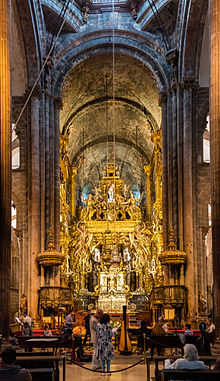Last year we travelled in our ‘furgo’ to the north of Spain. Not a great hardship – great cuisine, ocean views, wildness and civilisation. The north, Asturias and Galicia in particular are Celtic lands. Gayle was really sure there was something in the land from the Celtic days of Christian faith, though there was no evidence on the landscape of that, so as we travelled we called for the re-awakening of that manifestation of faith.
 The ‘camino’ (pilgrimage) to Santiago de Compostela is over 1000 years old and has been increasing in numbers. In some recent years over 1/4 million pilgrims have been on that path. For many it is a path of faith and they find a renewal of their faith. We have locally a friend who went on it last year. He confessed to not having personal faith, but was convinced that there was great value in journeying where others had found what they were looking for. So a mix of people go on the journey. We have even talked about whether we should make the journey to connect with people who are seeking faith… then Gayle said in one of her responses – maybe we should walk away from Santiago, do it in reverse! That quite appealed.
The ‘camino’ (pilgrimage) to Santiago de Compostela is over 1000 years old and has been increasing in numbers. In some recent years over 1/4 million pilgrims have been on that path. For many it is a path of faith and they find a renewal of their faith. We have locally a friend who went on it last year. He confessed to not having personal faith, but was convinced that there was great value in journeying where others had found what they were looking for. So a mix of people go on the journey. We have even talked about whether we should make the journey to connect with people who are seeking faith… then Gayle said in one of her responses – maybe we should walk away from Santiago, do it in reverse! That quite appealed.
We are always amazed that whenever something new comes up for a focus that a pattern seems to follow:
- A conviction that this is what should be done.
- A beginning of research that seems not to be too fruitful.
- A setting of one’s heart to the journey thinking ‘and so what are we going to do?’
- A coming together of random dots.
- Information that was probably always there becoming visible.
Well that is what seems to be happening. But back to the north and the Celts.
There was a Christian movement in the north and it was strongly in evidence in the 4th Century. The main leadership for the movement came from, Priscillian, whose views were at odds with the established bishops. He was opposed to hierarchy, pushed away from the centre, encouraged meetings in homes and in the country. All of this proved too much for the powers and he was arrested, taken to Trier in Germany. The Christian powers in conjunction with the Imperial powers had him tried for heresy and killed.
- He seems to be the first believer killed by fellow believers through co-opting the civil powers.
- That part of the story is very reminiscent of an event in Jerusalem!
- The sibling rising against another is a repeating pattern of history inside Spain – indeed one could argue across Europe.
The startling part of the info we are working with is that far from James being buried in Santiago (as if!!) that there is a strong suggestion that it is in fact Priscillian. The late Henry Chadwick, who was an Anglican and a scholar has strongly argued for that – quite remarkable as Priscillian has been labelled as a heretic by many in the more mainstream background.
There is the strong suggestion that the very camino was invented to crush out the continuing memory of Priscillian. A myth created to solidify both political and religious power and control.
Although a myth God can and does meet people in the midst of it all. That is the nature of God! In line with our perspective of the parallel journeys of Jesus to Jerusalem (‘no prophet can die outside of Jerusalem’) and Paul’s journey to Rome, the first to expose the alignment of religious and political power and to break their power. Once that is done Imperial power can be addressed.
So we will be off to Santiago. Walking away from there – the jury is out on that.
Living here on the east coast. Why? Well dreams took us here, but now we discover that the centre for the expulsions (post 1492 and the fall of the final Islamic city of Granada) was right here in the communidad of Valencia. Nice to be in the right setting… days after discovering the material on Prisicillian / Santiago we discovered that the Guardian newspaper had just reviewed a book on the expulsion of the Muslims, with the focus on this region. The book is on the way in the mail… another release of info once the timing is right.
